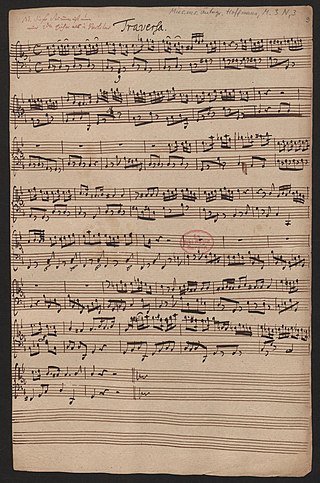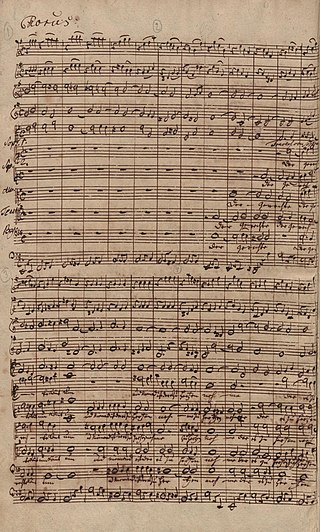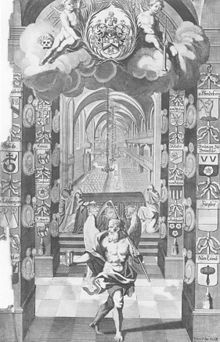
Georg Philipp Telemann was a German Baroque composer and multi-instrumentalist. He is one of the most prolific composers in history, at least in terms of surviving oeuvre. Telemann was considered by his contemporaries to be one of the leading German composers of the time, and he was compared favourably both to his friend Johann Sebastian Bach, who made Telemann the godfather and namesake of his son Carl Philipp Emanuel, and to George Frideric Handel, whom Telemann also knew personally.

Gleichwie der Regen und Schnee vom Himmel fällt, BWV 18, is an early church cantata by Johann Sebastian Bach. He composed it in Weimar for the Sunday Sexagesimae, the second Sunday before Lent, likely by 1713.

Ich will den Kreuzstab gerne tragen, BWV 56, is a church cantata composed by Johann Sebastian Bach for the 19th Sunday after Trinity. It was first performed in Leipzig on 27 October 1726. The composition is a solo cantata because, apart from the closing chorale, it requires only a single vocal soloist. The autograph score is one of a few cases where Bach referred to one of his compositions as a cantata. In English, the work is commonly referred to as the Kreuzstab cantata. Bach composed the cantata in his fourth year as Thomaskantor; it is regarded as part of his third cantata cycle.

Erdmann Neumeister was a German Lutheran pastor and hymnologist.

The Cantata Cycle 1716–1717 is a series of cantatas written by Georg Philipp Telemann while he was Frankfurt's Director of Municipal Music. In addition to composing music for civic occasions, he conducted and composed for several churches in the city, including the Katharinenkirche and the Barfüßerkirche where he was Kapellmeister. During his time in Frankfurt (1712–1721), he composed five new year-long cycles of sacred music for the Sundays and holy days of the ecclesiastical calendar. He also completed several cycles which he had begun earlier in Eisenach where he had been the leader of the court singers. After taking up his post in Hamburg in 1721, he continued to supply Frankfurt with cantata cycles—one complete cycle every three years, as part of an arrangement to maintain his citizenship of that city.

Uns ist ein Kind geboren, BWV 142 / Anh. II 23, is a Christmas cantata by an unknown composer. In the Bach-Werke-Verzeichnis it is listed among the works with a doubtful attribution to Johann Sebastian Bach. The text is based on a libretto by Erdmann Neumeister first published in 1711. Although attributed to Bach by the Bach-Gesellschaft when they first published it in the late nineteenth century, that attribution was questioned within thirty years and is no longer accepted. Johann Kuhnau, Bach's predecessor as Thomaskantor in Leipzig, has been suggested as the probable composer, but without any certainty.
As Thomaskantor, Johann Sebastian Bach provided Passion music for Good Friday services in Leipzig. The extant St Matthew Passion and St John Passion are Passion oratorios composed by Bach.

Der Tod Jesu is an oratorio libretto by Karl Wilhelm Ramler. In its setting by Carl Heinrich Graun in 1755, it was the most often performed Passion of the 18th century in Germany.

Ich lebe, mein Herze, zu deinem Ergötzen, BWV 145, is a five-movement church cantata on a libretto by Picander which Johann Sebastian Bach, as its composer, probably first performed in Leipzig on Easter Tuesday, 19 April 1729. As a seven-movement pasticcio, with one of the added movements composed by Georg Philipp Telemann, it is an Easter cantata known as So du mit deinem Munde bekennest Jesum or as Auf, mein Herz!.
Das ist je gewißlich wahr, TWV 1:183, is a cantata by Georg Philipp Telemann. Due to an erroneous attribution to Johann Sebastian Bach, it appears in the Bach-Werke-Verzeichnis (BWV) as No. 141, but was moved to Anhang III, the Appendix of spurious works, in the 1990s second edition of that catalogue.
Ich weiß, daß mein Erlöser lebt, TWV 1:877, BWV 160, is a church cantata composed around 1725 by Georg Philipp Telemann for Easter Sunday, formerly attributed to Johann Sebastian Bach.
Gott der Hoffnung erfülle euch, TWV 1:634, BWV 218, is a church cantata by Georg Philipp Telemann formerly credited to Johann Sebastian Bach. It was composed for Whit Sunday in Eisenach in 1717, with text by Erdmann Neumeister. The closing chorale is the first stanza of Martin Luther's hymn for Pentecost "Komm, Gott Schöpfer, Heiliger Geist".
Siehe, es hat überwunden der Löwe, TWV 1:1328, BWV 219, is a church cantata by Georg Philipp Telemann, written for Michaelmas in 1723. Formerly the cantata was accredited to Johann Sebastian Bach.

Georg Melchior Hoffmann was a Baroque composer who was influential as the leader at the Collegium Musicum in Leipzig. Some of his compositions have been mistaken for those of Johann Sebastian Bach.

Wer ist der, so von Edom kömmt is a pasticcio Passion oratorio based on compositions by Carl Heinrich Graun, Georg Philipp Telemann, Johann Sebastian Bach and others. The pasticcio was assembled around 1750.
The Telemann-Werke-Verzeichnis, abbreviated TWV, is the numbering system identifying compositions by Georg Philipp Telemann, published by musicologist Martin Ruhnke.

On Trinity Sunday 27 May 1725 Johann Sebastian Bach had presented the last cantata of his second cantata cycle, the cycle which coincided with his second year in Leipzig. As director musices of the principal churches in Leipzig he presented a variety of cantatas over the next three years. New cantatas for occasions of the liturgical year composed in this period, except for a few in the chorale cantata format, are known as Bach's third cantata cycle. His next cycle of church cantatas, the Picander cycle, did not start before St. John's Day 24 June 1728.
In music, a dictum is a type of libretto for a church cantata consisting of quotes from sacred scripture.

There are four church cantatas by Georg Philipp Telemann sharing the title Singet dem Herrn ein neues Lied:














